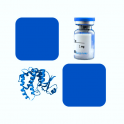
- Remove this product from my favorite's list.
- Add this product to my list of favorites.
Products
Viewed products
Newsletter
 |  |  |  |  |  |

Background
CD6 (Cluster of Differentiation 6) is a cell surface glycoprotein that is involved in T cell activation and a member of the scavenger receptor cysteine rich protein superfamily (SRCRSF). CD6 is expressed at low levels on immature thymocytes and at high levels on mature thymocytes. The majority of peripheral blood T cells, a subset of B cells, and a subset of neuronal cells express CD6. CD6 appears to play a role as both a costimulatory molecule in T cell activation and as an adhesion receptor. Studies demonstrating a mitogenic effect for T cells with some CD6 specific monoclonal antibodies, in conjunction with either accessory cells or PMA and anti-CD2 mAb, support the concept of CD6 as a co stimulatory molecule.
Source
Recombinant Human CD6, His Tag (CD6-H52H7) is expressed from human 293 cells (HEK293). It contains AA His 18 - Glu 398 (Accession # P30203-1).
Predicted N-terminus: His 18
Molecular Characterization
This protein carries a polyhistidine tag at the C-terminus.
The protein has a calculated MW of 42.5 kDa. The protein migrates as 60-90 kDa under reducing (R) condition (SDS-PAGE) due to glycosylation.
Endotoxin
Less than 1.0 EU per μg by the LAL method.
Purity
>90% as determined by SDS-PAGE.
Formulation
Lyophilized from 0.22 μm filtered solution in PBS, pH7.4. Normally trehalose is added as protectant before lyophilization.
Reconstitution
See Certificate of Analysis for reconstitution instructions and specific concentrations.
For best performance, we strongly recommend you to follow the reconstitution protocol provided in the CoA.
Storage
For long term storage, the product should be stored at lyophilized state at -20°C or lower.
Please avoid repeated freeze-thaw cycles.
This product is stable after storage at:
-20°C to -70°C for 12 months in lyophilized state;
-70°C for 3 months under sterile conditions after reconstitution.
(1) "Association of Polygenic Variants Involved in Immunity and Inflammation with Duodenal Ulcer Risk and Their Interaction with Irregular Eating Habits"
Park, Liu, Huang
Nutrients (2023) 15 (2)
(2) "The combination of SMRT sequencing and Illumina sequencing highlights organ-specific and age-specific expression patterns of miRNAs in Sika Deer"
Jia, Wang, Ma et al
Front Vet Sci (2022) 9, 1042445
(3) "Analysis of herpesvirus infection and genome single nucleotide polymorphism risk factors in multiple sclerosis, Volga federal district, Russia"
Lezhnyova, Davidyuk, Mullakhmetova et al
Front Immunol (2022) 13, 1010605
Showing 1-3 of 668 papers.
Follow us